Scientific name: Datura wrightii Regel
Common names: sacred datura, sacred thornapple, jimson weed
Family: Solanaceae
Article by Peggy Rudberg
One of the largest wildflowers in the Southwest, the showy white flowers of the Datura wrightii can spread as wide as eight inches in diameter. The cigar-shaped buds unfold into a fragrant tubular corolla with five fused lobes displaying narrow teeth at the outer edge of each joint. Five stamens and one anther reach out from a greenish center.
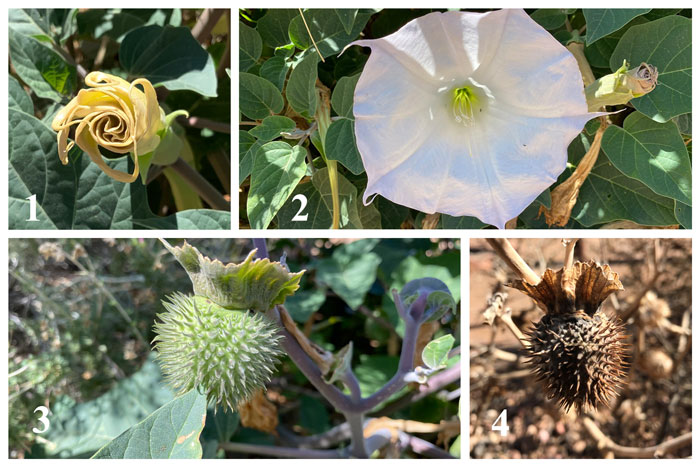
Datura flower and seed pods in Botanical Garden. 1. Flower bud furled. 2. Open flower. 3. Seed pod (photo by Kathy Haq). 4. Dried seed pod.
A hint of pinkish lavender highlights the edges of the petals, drawing admirers such as Georgia O’Keeffe to the Datura genus. In the 1930’s she created 2 paintings of Datura stramonium, one of at least eight similar species, and titled them Jimson Weed, one of the common names of the Datura genus along with sacred datura and thornapple. These common names vary with location.
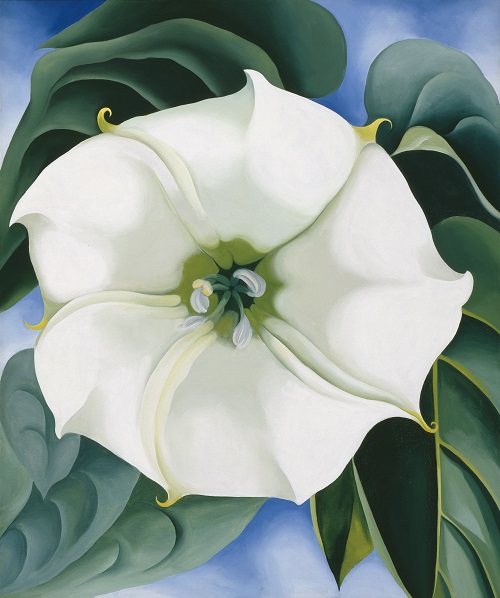
Georgia O’Keeffe. Jimson Weed/White Flower No. 1, 1932. Oil on canvas, 48 x
40″ (121.9 x 101.6cm). Crystal Bridges Museum of American Art. © Georgia
O’Keeffe Museum
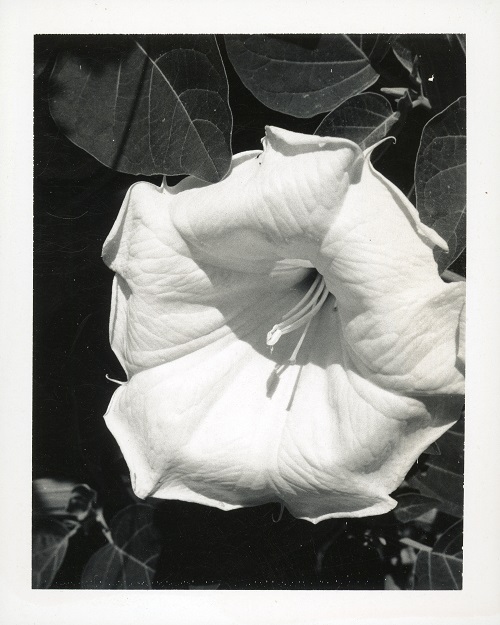
Georgia O’Keeffe. Jimsonweed (Datura stramonium), 1964-1968. Polaroid print,
3 3/4 x 2 7/8 inches. Georgia O’Keeffe Museum. Gift of The Georgia O’Keeffe
Foundation. © Georgia O’Keeffe Museum. [2006.6.1070]
The plant itself is vigorous and can sprawl up to four or five feet. Large alternate leaves have varied margins, sometimes wavy or coarsely lobed. The smell of the herbage has been compared to a wet dog. Both the stem and leaves have fine minute hairs. Stems are not woody and the plant dies back completely in the fall leaving only the fleshy taproot.
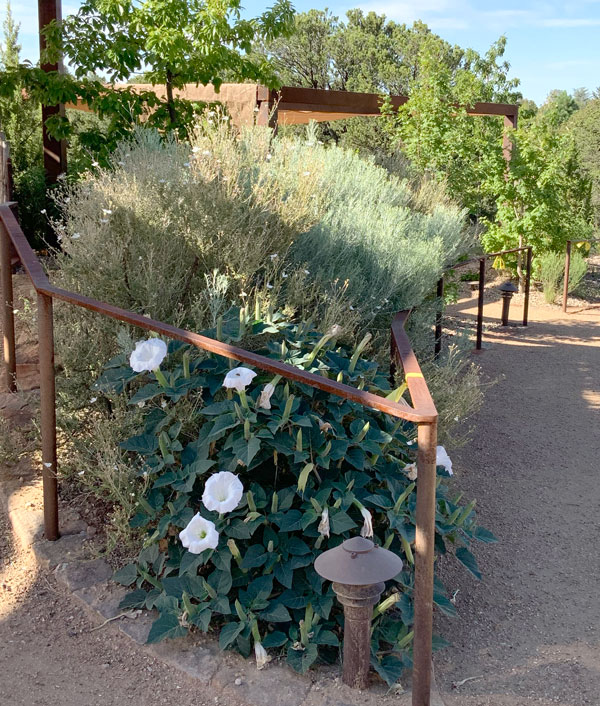
Datura growing in Garden.
The plant will reemerge in the spring for several years but also reproduces from its seeds. The fruit is a spiny walnut sized spherical capsule and hangs from the stems. When the fruits ripen they burst open scattering several hundred flat bean shaped seeds that are viable for years.
This deciduous perennial herb is native to the Southwest and South Central United States and Northern Mexico but has been widely naturalized in most of the lower forty-eight states and has been introduced worldwide. It flourishes in well drained, sandy soils in temperate climates and can tolerate alkaline and clay soils. Often found in canyons, washes and desert scrub and grasslands at elevations from 1000 to 7000 feet it is hardy to USDA Zone 6. It prefers full sun but can tolerate some shade. It rarely suffers pest problems and demands little water. Sacred datura can grow and re-seed fairly aggressively, especially in garden conditions or moist soils, as when summer monsoon rains are generous. As beautiful as it is, care should be taken in introducing this plant into a cultivated garden, given its large size, sturdy taproot, abundant seeds, and toxic properties.
The genus Datura belongs to the Solanaceae family, also known as the nightshade family, most of which contain poisonous alkaloids such as solanine and atropine. Some tubers and fruits of other members of the nightshade family, such as potatoes and tomatoes, either have less alkaloids or lose their toxicity during ripening. All parts of Datura can cause negative reactions to humans and animals from skin irritations to hallucinations to even possibly death. The seeds and roots contain the greatest concentration of poison, but wash your hands well after handling any part of the plant.
At the Santa Fe Botanical Garden, the D. wrightii is found in Ojos y Manos, our collection of plants with traditional uses.
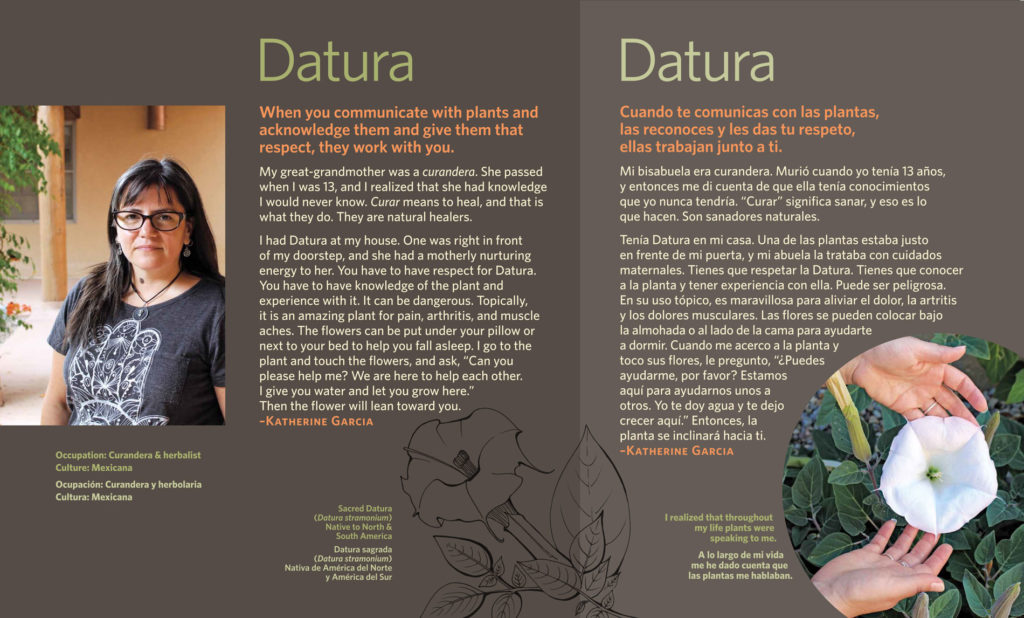
It has been used by Puebloans for centuries, chiefly as a painkiller or in religious ceremonies under the guidance of local experts. To quote a common idiom “Do not try this at home.”
References
Bronstein, Judith L. et al. “Reproductive biology of Datura wrightii: the benefits of a herbivorous pollinator.” National Library of Medicine. 2009. Web. 8 Dec. 2022. Retrieved from: https://www.ncbi.nlm.nih.gov/pmc/articles/PMC2701751/
“Datura wrightii”. Garden Explorer. Santa Fe Botanical Garden. Web. 26 Dec. 2022. Retrieved from https://santafebotanicalgarden.gardenexplorer.org/taxon-755.aspx
Georgia O’Keeffe. Jimson Weed/White Flower No. 1, 1932. Oil on canvas, 48 x 40″ (121.9 x 101.6cm). Crystal Bridges Museum of American Art. © Georgia O’Keeffe Museum
Georgia O’Keeffe. Jimsonweed (Datura stramonium), 1964-1968. Polaroid print, 3 3/4 x 2 7/8 inches. Georgia O’Keeffe Museum. Gift of The Georgia O’Keeffe Foundation. © Georgia O’Keeffe Museum. [2006.6.1070]
“Jimson Weed.” 2021. Web. 8 Dec. 2022. Retrieved from: https://www.georgiaokeeffe.org/jimson-weed/
Schalau, Jeff. “Sacred Datura.” Backyard Gardener. 2001. Web. 8 Dec. 2022. Retrieved from : https://ag.arizona.edu/yavapai/anr/hort/byg/archive/sacreddatura.html
Sharp, Jay W. “Datura – Jimson Weed.” DesertUSA. 1996-2022. Web. 8 Dec. 2022. Retrieved from: https://www.desertusa.com/flowers/datura-jimson-weed.html


